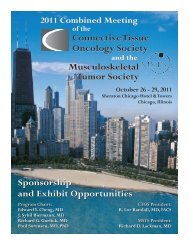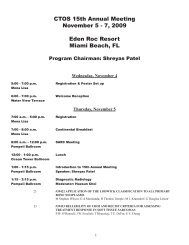207 Poster Session 2 - Connective Tissue Oncology Society
207 Poster Session 2 - Connective Tissue Oncology Society
207 Poster Session 2 - Connective Tissue Oncology Society
You also want an ePaper? Increase the reach of your titles
YUMPU automatically turns print PDFs into web optimized ePapers that Google loves.
Scientific <strong>Poster</strong>s – <strong>Poster</strong> <strong>Session</strong> 2be offered to those patients with poor chance of salvage.<strong>Poster</strong> #109ANTI TUMOR EFFECT OF VEGF TARGETEDTHERAPY ON SYNOVIAL SARCOMAToru Wakamatsu 1 ; Norifumi Naka 2 ; Takaaki Tanaka 1 ;Nobuhito Araki 3 ; Takafumi Ueda 4 ; Hideki Yoshikawa 2 ;Kazuyuki Itoh 11Biology, Osaka Medical Center, Osaka, Japan; 2 Orthopaedics,Osaka University Graduate School of Medicine, Osaka, Japan;3Orthopaedic Surgery, Osaka Medical Center, Osaka,Japan; 4 Orthopaedic Surgery, Osaka National Hospital,Osaka, JapanObjective: Synovial sarcoma (SS) has highly metastaticpotential and poor prognosis, due to their chemo- andradio-resistance, thus a novel therapy is needed. In orderto examine the anti-tumor effect of VEGF targeted therapyagainst SS, we herein used two human SS cell lines establishedin our laboratory. We also used Bevacizumab (Bev),a humanized monoclonal antibody against VEGF, has beenapproved to clinically improve the prognosis with severalmalignancies by inhibiting angiogenesis and proliferationof primary and metastatic sites. On the contrary, severalstudies reported that inhibition of VEGF signal increasedtumor invasion and lung metastasis depending on HIF1α.In this study we examined the effect of VEGF-targetedtherapy for SS by combination with Ifosfamid (IFO).Methods: In vitro, we measured the level of vascular endothelialgrowth factor (VEGF) in 3 dimensional (3D) andadhesion (2D) cultures of these SS cells by ELISA. Inhibitionof colony formation with the treatment of Bev and/orIFO was examined by soft agar assay. In vivo, we measuredthe tumor volume every week in xenograft models.Results: These SS cells produced markedly higher levelof VEGF in 3D compare to 2D cultures. In soft agar assay,treatment with Bev inhibited the colony formation of thesetwo SS cells, and combination treatment of Bev with Ifosfamideshowed higher efficiency. However, proliferationof two SS cell lines on 2D cultures couldn’t be inhibited bythe treatment with Bev. In xenograft models, the combinationtherapy also effectively reduced the tumor volumewithout any adverse effect. We are currently focusinghow Bev inhibited tumor growth in 3D but not on 2D.Conclusion: Collectively VEGF-targeted therapy can beproposed as a novel therapy for SS by combination withcurrent chemotherapy.<strong>Poster</strong> #110CELL CONTEXT IS AN IMPORTANT FACTORFOR THE ROLE OF SYT-SSX ON EPIGENETICREGULATION OF TRANSCRIPTIONSakura Tamaki; Tomohisa Kato; Kazuo Hayakawa;Naoko Takahara; Yoichiro Kajita; Junya ToguchidaDepartment of <strong>Tissue</strong> Regeneration, Institute for FrontierMedical Sciences, Kyoto University, Kyoto, JapanObjective: Synovial sarcoma (SS) is a soft tissue sarcomacharacterized by the SYT-SSX fusion gene. Variety ofstudies implicated that SYT-SSX contributes the developmentof SS by modifying the physiological regulation ofgene expression and exerts its function through chromatinremodeling. However, the molecular mechanism howSYT-SSX dysregulates target genes remains unclear. Wepreviously identified the FZD10 gene as an SS-specificallyup-regulated gene. In this study, we investigate the functionof SYT-SSX as an epigenetic modifier by the preciseanalyses of its regulation on the FZD10 gene.Methods: Transcriptional core regulatory region of theFZD10 gene was identified by luciferase reporter assay,and histone modifications in the region were analyzedby ChIP assay. The SYT-SSX gene was knocked-down inFZD10-positive SS cells, or overexpressed in FZD10-negativehuman embryonic stem cells (hESCs) and human skinfibroblasts (hSFs), and the expression of FZD10 gene andhistone modifications were analyzed in these cells.Results: As expected, histones were modified as an activestatus in SS cells; H3 was highly acetylated and H3K4 washighly methylated. On the other hand, in hSF, H3K27 washighly trimethylated (me3) and EZH2, a component of PcG,occupied in this region indicating a repressed status. Intriguingly,hESCs contained both H3K4me3 and H3K27me3indicating “bivalent” status. Knockdown of SYT-SSX in SScells downregulated the FZD10 expression in associationwith increased H3K27me3, whereas the ectopic expressionof SYT-SSX induced the expression of FZD10 changinghistone status from bivalent to active. Such induction ofFZD10 was not observed in hSF with ectopic SYT-SSXsuggesting the importance of original histone status forthe induction. Intriguingly, the combination of SYT-SSXexpression and HDAC inhibitor successfully induced theexpression of FZD10 in hSF.Conclusion: A number of studies have been done to identifydown-stream molecules of SYT-SSX by overexpressionassay with little consideration of recipient cells. Our resultsin this study, however, clearly indicated that original chromatinsignature of target gene has a great impact on theeffect of SYT-SSX, and therefore cell context is an importantfactor for the function of SYT-SSX as an epigenetic modifier,which should be seriously considered in future studies.216






